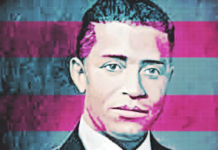This article first appeared on the Teaching While White website. It is reprinted here with permission of the author.
I was socialized as a white girl in a state that is 94 percent white.
I had a wonderful childhood: sufficient resources, supportive parents, dedicated teachers, and positive, affirming experiences at the public and private schools I attended. I felt seen and safe in the classroom, free to be myself and to pursue my interests — an experience that only now, as a teacher, do I realize is a privilege available to many more white students than students of color.
Throughout my childhood, the whiteness of my surroundings remained invisible to me. I never noticed, named, addressed, or challenged it. Nor did anyone else, as best I can tell. White was simply “normal,” and I accepted this norm as easily and unquestioningly as I conformed to the silent expectations around me. I did not know then that my lack of awareness came at a price, not only to others, but also to me.
In my seventh-grade geography class in the late 1990s, we studied the continent of Africa and apartheid in South Africa. I remember my white teacher, an energetic man in his early thirties, drawing a mess of arrows on the board to illustrate European colonization. Now a thirty-something middle school teacher myself, I recently uncovered a worksheet I had completed after watching the 1992 film Sarafina!, starring Whoopi Goldberg.
One of the short-answer questions immediately caught my eye: “In 5 sentences please explain how you would have acted in South Africa, would you have been a rebel, an activist, a person in the middle or not got involved at all? please use at least five sentences.[sic]”
In neat printing was my answer:
“I would not get involved. I know I should be an activist, but I can’t stand violence of any kind. I’d rather live a life of injustice and safety than justice and constant fear and danger. It’s not right, but it’s how I feel. This country was not founded by people like me.”
Below my response, my teacher had scrawled simply the word “Good.”
Rereading this assignment as an adult, I was overwhelmed with guilt and shame and felt the urge to travel back in time to shake some sense into my seventh-grade self. What could have led her to write this infuriating answer? How could she have been so callous, so cowardly, so selfish? At the heart of my anger and disappointment was fear: Is this the person who, despite my best efforts, I will always be? Am I so fearful for myself, despite my position of privilege, that I am resigned to turning my back on others who are oppressed?
How did I become the twelve-year-old who wrote this answer? Thinking back, I can identify three aspects of my personality, shaped by society’s expectations of my race and my gender, that help me to better understand the person that I was.
The first is that I was compliant. I learned early on how to follow directions, how to sit quietly, how to smile and please adults. My mild and agreeable nature was valued by those around me, and also meant that I was easily dominated by others. My earliest memories of friendship involved being bossed around by my peers, obediently playing the horse that others rode in the recess yard. I remember desperately having to go to the bathroom in first grade, and being told by my best friend that if I went inside, she wouldn’t sit next to me anymore or invite me to her birthday party. Faced with this unthinkable threat, I put my bodily needs aside and remained outside. I followed the path of least resistance, regardless of the cost.
I was tenderhearted. Fascinated by all living things, I had a habit of finding and collecting small critters so as to observe and care for them. When I was eight years old, I discovered a mother spider with an egg sac and carefully transported both to a tiny house I had built out of plywood and mesh screen. When I came to check on them the next morning, I was horrified to discover that the egg sac was open, the cage was swarming with ants, and the spider was dead. I buried her with the remains of the egg sac in the garden, and made a tiny gravestone on which I wrote “Mother Spider” and the year with a black Sharpie. I could not bear to see a living creature harmed.
I was conflict-averse. In my family, I played the role of the peacekeeper. I was slow to anger and quick to apologize, an unusual temperament in my family. My parents praised my calm and forgiving character and I came to see it as a virtue. A bookish New England girl, I obsessively read and re-read Little Women between the ages of ten and twelve, fascinated by the lives and personalities of the March family. While nearly everyone I knew identified with the strong-willed and independent protagonist Jo, I saw myself clearly in her younger sister Beth, the kind sister, the weak sister, the one who plays the piano, the one who dies. I knew even then that I was not strong, but that I was kind, and that was almost as good.
When I remember the child that I was, following the path of least resistance, sheltered from the realities of injustice around me, I understand her differently. I see that she was raised to be a nice, polite, well-intentioned bystander, bred to be complicit in others’ oppression through inaction. This perspective allows me to quell my anger with my seventh-grade self and, instead of shaming her, to hear her heartbreak. She desired to be kind and do good. But she did not see herself as capable. She did not know how.
I wonder about my teacher’s response to my answer. His seemingly simply affirmation remains inscrutable to me even now. “Good”? What was good? That I had followed directions, writing exactly five sentences (as stipulated twice in the directions)? That I had spelled all of the words correctly? That I had answered honestly? That I had made a conscious choice to put my own comfort above safety and justice for others? That I had used my aversion to violence as an excuse to comply with a violent system?
Here’s the thing about my seventh-grade self: I knew how to spell. I knew how to follow directions. I knew how to write in complete sentences. What I didn’t know was how to be a person in the world: a person becoming aware of oppression but who was not oppressed, a person who benefitted from the privilege of choosing whether or not to act, a person who wanted, but was unable, to put her own fear aside to advocate for others. Where was the teacher who would teach me that?
Where was the teacher to make visible to me the crux of my dilemma: how to be a white person in a racist world?
Here’s what I imagine my teacher could have written to me beyond “good,” what I hope I am able to convey to my own white middle school students.
Dear Student,
You’re white. So am I. We didn’t choose the color of our skin, and there’s nothing wrong with it. What is wrong, though, are the systems that have been set up in our world that value certain skin colors and physical traits over others. And the scary thing is that this isn’t just about apartheid in South Africa. Racism exists here and now, in our country and in our state and in our school, and the fact that it’s so hard to see tells us just how deep it runs.
The thing about being white is that we are never the victims of this system. Even though it is unjust and utterly ridiculous to assign value to something as meaningless as race, our society does just this. For us white people, racism is something that we get to think about if we want to, and not think about the rest of the time. The color of our skin doesn’t make our intentions or skills suspect in the eyes of authorities, or make us the targets of violence, or make us less likely to get a job or a loan or a home. This unearned privilege feels as natural to us as breathing because we are so used to it, but that doesn’t make it any less unfair or its effects any less devastating.
Whether we want it or not, we are part of a racist system. The truly awful part is that we white people actually benefit from the oppression of people of color, with advantages that accumulate while others are disadvantaged. Once you start to notice and pay attention to the inequality around you, it can feel really scary and sad. You might feel powerless and guilty — I know I have felt that way. That discomfort, though, is actually a good thing, because once we begin to understand the injustice around us, we can take a stand against it. We can be part of a change.
Remember that even though we might feel helpless, the privilege we benefit from makes us anything but helpless. Because of racism, white people often have access to powerful resources, spaces, and people. We can speak up about injustice without being accused of “playing the race card” or being an “angry black person.”
We can help to make marginalized voices heard in spaces in which they are not represented. We can advocate for change in our political system. We can urge others to donate their money to fight racism and benefit people of color. For me, it’s not just about what I can do, but what I have to do. As a human, it makes me feel terrible to know that my security comes at others’ expense. I hear that pain in your answer and I invite you to use your empathy to empower your action. For, as Desmond Tutu once wrote, “If you are neutral in situations of injustice, you have chosen the side of the oppressor.”
Know, too, that fighting injustice can look like lots of different things. Not everyone will start a protest or lead a political revolution. It can start small: by educating yourself, by learning about current events and about history, and by listening to people share experiences that are different than yours. By speaking up when you disagree. By telling the truth, even when it’s hard. Because in order to change this unfair system, we need to challenge it. I hear you say, in your answer, that you couldn’t stand a life of violence and fear. I want you to know that not all resistance is violent but that oppression always is. Your honesty and self-knowledge are a sign of strength, and I think that you are braver than you know. I know that you can be a force for change.
Let’s keep talking.
In solidarity,
Your Teacher
Julia Donnelly Spiegelman has spent the past ten years teaching foreign languages and social justice. She holds an M.A. from Middlebury College, where she was awarded the Kathryn Davis Fellowship for Peace. She is currently a doctoral student at the University of Massachusetts Boston and a faculty member of the Multicultural Teaching Institute (MTI).










